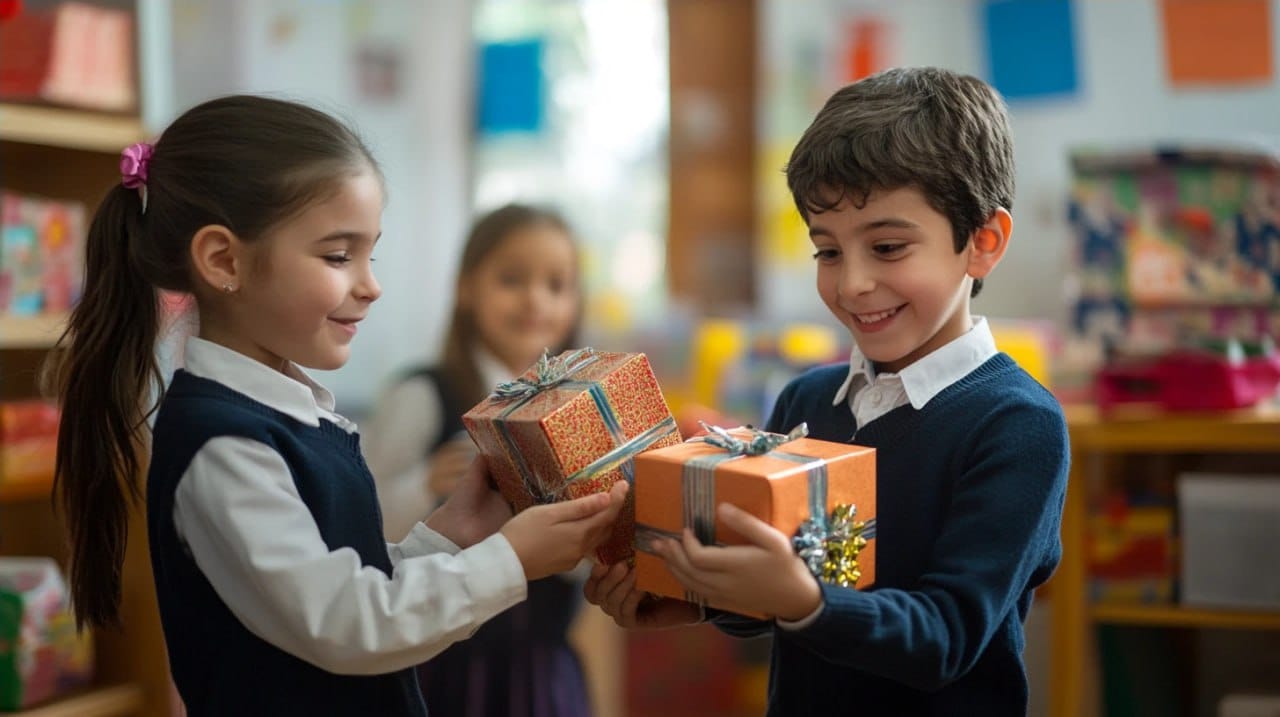How to teach your kids the joy of giving this Christmas
Christmas is the perfect time to teach valuable lessons about generosity and kindness. This article offers advice on how to teach your children gratitude and compassion, and how to inspire them to embrace the joy of giving this Christmas.

You can either become a role model for your kids or teach them through stories and fairy tales. This way children will realize that to give gifts might be more exciting than to receive them.
Set an example
Kids learn by observing the actions of the adults around them, so demonstrating kindness and compassion is crucial. When parents and caregivers consistently show empathy and patience, kids are more likely to adopt these behaviors.
Adults can perform small acts of kindness, such as holding the door for someone, saying a kind word, helping an elderly person carry heavy items, or sharing treats with other kids. Afterward, they can discuss these actions together, explaining their significance and reinforcing why kindness is important.
By setting a positive example and engaging in thoughtful conversations, parents can encourage kids to develop a lifelong habit of generosity and empathy.
Five acts of kind behavior parents can show to kids
1. Helping a neighbor — Offering to carry groceries, mow the lawn, or check in on an elderly neighbor.
2. Showing gratitude to service workers — Saying "thank you" to cashiers, waiters, and delivery workers sets an example of respect and appreciation to anyone.
3. Donating to those in need — Giving clothes, toys, or food to charities or shelters teaches children to share and care for those less fortunate.
4. Holding the door open for others — Simple acts of politeness demonstrate everyday kindness and attention to others.
5. Offering encouragement and support — Complimenting someone, encouraging a friend or acquaintance shows children how words and actions can lift someone’s mood.
Encourage gratitude
Teaching children to appreciate what they have helps them develop a thankful mindset. Instead of complaining about lacking many toys or belongings, they should focus on things that are often taken for granted, such as a home, food, heating, good health, and a loving and caring environment.
Tell your kids stories about people who struggle to survive yet remain grateful for their lives. When children learn to be grateful, they are more likely to develop empathy and generosity, leading to a stronger and happier outlook on life.
Volunteer together
Volunteering is a great way to instill a sense of responsibility and empathy in kids. Engaging in activities such as serving food to the homeless, cleaning up a park, or visiting a nursing home helps them understand the impact of helping others.
Volunteering helps kids recognize the challenges others face, fostering greater compassion. It also provides meaningful bonding experiences that strengthen family values and teamwork. Through active participation in community service, kids learn that even small efforts can have a significant impact on others' lives.

Help kids understand compassion
Feeling compassion is of utmost importance for every happy human. Compassionate kids can recognize and respond to the emotions of others with kindness and care. When they develop a deep sense of compassion, they are more likely to treat others with respect, fairness, and openness throughout their lives.
Five steps to build compassion in kids
1. Model compassionate behavior. Show kindness, empathy, and understanding of other people’s needs in your daily life. Explain to your kids how to express gratitude to others.
2. Encourage self-talk. Teach kids to put themselves in others' shoes by asking questions like, "How do you think they feel?" Read books or watch stories that highlight empathy and discuss the characters' emotions. Role-play different life situations to help them understand various perspectives.
3. Teach emotional awareness.Help your kids recognize and feel their emotions, highlighting that it is normal to feel any kinds of emotions. Guide them on how to treat other people whatever emotion they feel. Ask to talk about their feelings when expressing compassion.
Research shows that compassion positively influences kids’ emotional, social, and cognitive development. When kids experience or practice compassion, they develop greater empathy, emotional regulation, and social skills, helping them build healthier relationships. Additionally, compassion fosters a sense of belonging and cooperation, enhancing learning and teamwork in school settings.
Here is a story for kids about an act of compassion.
Lesson in compassion: This fable tells the story of a small mouse that helps a mighty lion by removing a thorn from its paw. Earlier, the lion had spared the mouse’s life, showing mercy despite its size. The story teaches kids that kindness, no matter how small, is valuable and can be repaid in unexpected ways. It encourages empathy by showing that even the smallest creatures deserve kindness.
Involve them in gift-giving
Tell your kids about different ways to give gifts to the people they like. For example, they might ask about others’ preferences in advance or pay attention to what people like during interactions.

One of the ways of gift giving is organizing a Secret Santa gift exchange. Children can exchange homemade gifts or affordable things bought in a shop. Parents should assist children in finding a proper gift. For younger children, you can use a hat or a box with the pieces of paper — they can pick the paper with the name of the gift recipient.
Adults can also enjoy the gift exchange even more by using the MySantaApp. With this online organizer, you can invite participants via email and draw names with a single click. Each person will secretly prepare a gift for someone else. Participants can add their gift wishes in the generator, making it easy to rely on their preferences.

Tell about the importance of giving
Giving not only brings joy and fun to both the giver and the receiver, but also fosters a sense of connection and admiration. Remind your kid that giving improves friendship and leads to more respect among friends.
It is also essential to praise your kid for fostering such behavior in the future. Here are five phrases to say to your kid:
"That was so kind of you to share! I am impressed with your generosity!"
"Wow! You have such a big heart, you are so caring!"
"I'm so proud of you for being so kind!"
"What a wonderful act of giving! It is really special!"
"You are amazing! When you give to others, you spread joy and kindness and set a good example to everyone!"
By using these phrases, you reinforce the importance of generosity and kindness in your child's mind. Encouraging and praising their acts of giving helps them develop a constant habit of compassion and empathy.
FAQs
What if the kid receives a bad reaction from another kid when giving something to others?
Explain to your kid that sometimes people have their own reasons for reacting negatively, and it’s not necessarily about them. Encourage your child not to stop being kind, as their good intentions are valuable, even if not everyone appreciates them.
When to start teaching your kid the joy of giving?
You can start teaching your child the joy of giving as early as toddlerhood, by encouraging small acts of kindness, like sharing toys. As they grow, you can guide them to understand the deeper value of giving through thoughtful actions and encourage them to make it a habit.
What are some gift exchange games to teach your kid the joy of giving?
Except for the Secret Santa gift exchange you can try different options to teach children the joy of giving. Game “Pass the Present” adds excitement by wrapping a gift in multiple layers, with kids passing it around and unwrapping a layer when the music stops until the final surprise is revealed. Another fun idea is Gift Bingo, where kids should “earn” small presents by completing kind acts, like saying a compliment to another kid.



